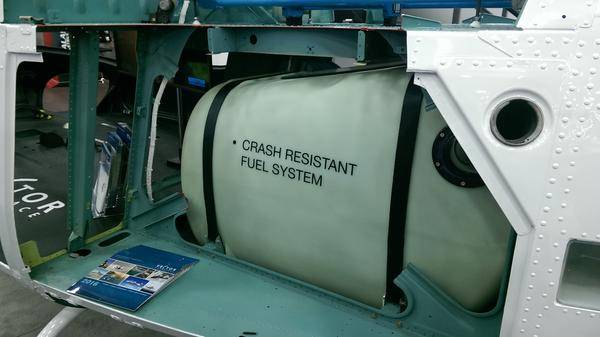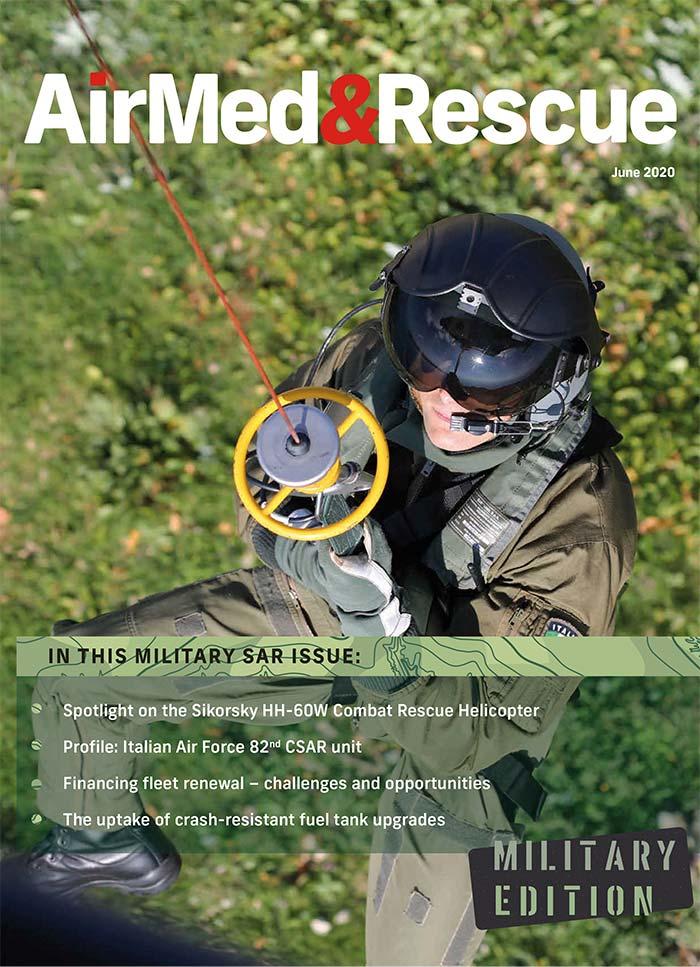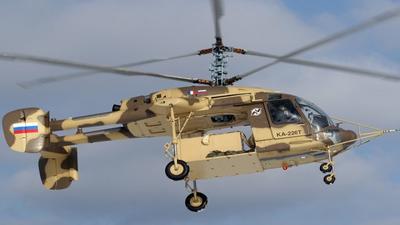Crash-resistant fuel systems - uptake by civil helicopter operators

Amy Gallagher updates readers on the long-awaited Federal Aviation Administration (FAA) regulation, with its final ruling and reporting analysis of the crash-resistant fuel systems (CRFS), along with the reaction of civilian helicopter operators and manufacturers
In 2015, the FAA published the results of an in-depth study that analyzed helicopter accidents involving post-crash fire and blunt force trauma, in response to the ‘unacceptably high’ fatal accident rates, notably two fatal accidents in July 2015, just 20 days apart. The study revealed only 16 per cent of the US helicopter fleet complied with the CRFS rule (14 CFR §27/29.952; Parts 27 and 29 of the FAA Regulation) that was introduced in 1994. Results from the same study showed that only 10 per cent met the emergency landing certification requirements of 1989, according to the Federal Register. Finally, the FAA study further concluded that 80 per cent of accident fatalities were caused by blunt force trauma; 20 per cent, meanwhile, were caused by post-crash fire. A fatal accident study showed both measures would have been effective in saving lives (Federal Register Vol 80 no 214).
The FAA Reauthorization Act of 2018 prohibits helicopters manufactured after April 2020 from flying in US airspace unless certified with a CRFS. The FAA Safety Team published a Safety Alert for Operators (SAFO) 19006-Crash Resistant Fuel System (CRFS) Safety Standards on 7 February 2020, the purpose of which is to inform registered owners and operators of helicopters about compliance standards for CRFSs.
Due to the FAA regulatory requirement, all helicopter models certified after 1989 must have crash-resistant seats and structures. However, if the original design was certified before 1989, the regulatory requirement does not apply. As a result, 30 years later, a low percentage of US helicopters have met the regulatory requirement. The FAA, however, has now stated that all helicopters manufactured after April 2020 will require CRFS, regardless of when the models were originally certified. The FAA reauthorization law of 2018 does not, however, require older helicopters to be retrofitted with CRFS retrofits. The current legislation does not address the installation of crash-resistant seats; however, all helicopter models certified after 1989 must have crash-resistant seats and structures. The requirements are consistent with recommendations provided to the FAA by the Aviation Rulemaking Advisory Committee (ARAC) Rotorcraft Occupant Protection Working Group (ROPWG) to improve rotorcraft fuel system crash resistance.

Robertson Fuel Systems
ROPWG
Dennis Shanahan, Chair of the ROPWG, retired from the US Army as a Flight Surgeon after 26 years. While his most recent service was commanding the US Army Aeromedical Research Laboratory (USAARL) in Fort Rucker, AL, Shanahan is known as one of the leading researchers in the country on crashworthiness of helicopter fuel tanks. Shanahan served on the military committee to design the crashworthiness standards for the UH-60 Blackhawk during the 1970s. “By 1976, and we already had CRFS in every helicopter in the Army,” he told AirMed&Rescue. For the past three years, Shanahan and the other 21 members of the ARAC ROPWG CRFS group have produced six (lengthy) reports during the past three years.
“The FAA asked the question, ‘How are we going to turn this around for the previously ‘grandfathered’ helicopters required to meet the standard and how much will it cost us’?” said Shanahan. “It is important to note that after writing all of those reports, we worked for the ARAC, not the FAA. After we submitted our final report, we did not get so much as a ‘thank you’ from the FAA. We never heard back from the FAA.”
It’s taken a lot of convincing to get changes made in civil aviation
Two House of Representatives in Colorado monitored the ROPWG – Ed Perimutter and Joe Neguse. They were very interested in CRFS. “The FAA wasn’t going to act on the implementation of CRFS, unless the two reps initiated a bill requiring all newly manufactured helicopters to meet CRFS standards,” Shanahan asserted. “The movement to pass the FAA Reauthorization Act 2018 was due to the direct communications from Rep. Perimutter, who put the budget in the FAA’s Act. That’s where the movement came from; it didn’t come from the FAA.” He continued: “Six ROPWG members representing six different manufacturers all standing behind the recommendations. No opposition from anyone in our group. The FAA was not very enthusiastic. The FAA did not do anything until Congress stepped in. It’s taken a lot of convincing to get changes made in civil aviation. Thank God at least, the CRFS has been dealt with in large part by Congress.”
FAA Publishes ‘Helicopter Occupant Safety Toolkit’
The FAA’s Tony Molinaro stated that the Toolkit was created so that all relevant information about new legislation could be accessed from one location. “The chart on the FAA-designed Toolkit shows which helicopters will require a CRFS according to their certification date and manufacturing date,” he said. “The general public is able to see what is and is not affected by the new occupant safety legislation.”
When asked if the FAA received any comments after the final ruling, Molinaro said: “The FAA will not speculate on the industry’s reaction to the new legislation.” When asked if the FAA planned to conduct a follow-up analysis to monitor the performance and progress of the new ruling, Molinaro said: “No decisions have been made about a follow-up study on helicopter occupant safety.”
Civil aviation adoption
“Air Methods has made it a priority to lead the way in the air medical transportation industry when it comes to meeting the standards for CRFS,” said Jason Quisling, VP, Flight Operations and Director, Operations, Air Methods. “We have been committed to this for several years and have completed nearly all of our retrofits. When it comes to air medical [operations], safety is the top priority for every element of our services. We are proud that our crash-resistant fuel program meets FAA standards for our aircraft, and look forward to continuing to provide the safest and most reliable care in the air for those in need of this crucial emergency medical service.”
In February 2018, Air Methods became the first to fly Airbus H125 helicopters retrofitted with FAA-certified CRFS
In February 2018, Air Methods became the first to fly Airbus H125 [formally, AS350] helicopters retrofitted with FAA-certified CRFS. The global leader in emergency air medical services invested approximately US$15 million to retrofit Airbus H125 and H130 [formerly EC130] fleet with the updated CRFS. To date, Air Methods has received and completed the installation of 11 CRFS at its heavy maintenance facility located in Colorado. The company intends to roll out an entire fleet of retrofitted Airbus H125 and H130 over the next two years.
Air Methods has been advocating for and supporting CRFS for several years. In 2015, Air Methods partnered with StandardAero (formerly Vector Aerospace) in seeking certification for a CRFS for all Airbus single-engine helicopters operated by Air Methods. As part of this partnership, Air Methods provided StandardAero with an aircraft to conduct CRFS testing, which was a necessary step for Supplemental Type Certification (STC) by the FAA.

StandardAero
Airbus Helicopters
Both the Airbus EC130 B4 retrofit kit and the Airbus AS350 B3 retrofit received EASA certification in January 2020, with FAA certification imminent. The FAA is currently processing the certification and the company expects the certification to come through in Q2, however, there could be delays to this date related to Covid-19.
The Airbus CRFS kit for the H125 (AS350 B3e) also received EASA certification for cargo swing operations, making it fully FAR 27.952 compliant. Both the B3 and B4 retrofit kits produced by Airbus will be available for installation in the next few months. As a reminder, the H130 has come standard with CRFS since its entry into service in 2012 and all H125s produced in the US facility in Mississippi have been standard with CRFS since 2016.
CRFS is now also standard for all new H125s produced worldwide
CRFS is now also standard for all new H125s produced worldwide. Any Airbus H125 or H130 family helicopter in service today that does not have a CRFS can be equipped through either an Airbus Helicopters or third-party approved retrofit solution, based on the model. Airbus now offers its own, OEM-produced CRFS retrofit kits for the AS350 B3e, AS350 B3, and EC130 B4.
Airbus hopes to encourage the implementation of this important safety feature industry-wide, and thus has been offering its CRFS retrofit kits at the below-cost price of $44,000 worldwide for the past year, and has been providing incentives to its customers who choose to retrofit their earlier fleet with a third-party solution for which Airbus doesn’t manufacture a retrofit kit.
“At Airbus, safety is our number-one priority and we strongly encourage all Airbus operators to implement the CRFS if their helicopter fleet doesn’t already have it,” Axel Aloccio, Head of Light Helicopters Program for Airbus Helicopters, said. “Recently we have extended the certification of the Airbus CRFS to two new variants – the AS350 B3 and the EC130 B4 models – in compliance with 27.952 standards,” said Aloccio. “Also, the H125 and AS350 B3 variants are now compatible with cargo swing operations,” he added.

“For older AS350 variants, we continue to support our customers willing to retrofit their aircraft with a third-party CRFS kit, by offering them training credits for each kit installed,” he said. “Airbus Helicopters strongly recommends that all of its customers operating any variant of the H125 and H130 families equip their aircraft with the CRFS solution of their choice.”
According to Anthony Baker, Vice-President of Customer Support, Airbus Helicopters North America, the industry is definitely demonstrating a ‘willingness to co-operate’ on this topic. “Our customers take safety very seriously and do what they can to implement new or enhanced safety features when it is available, hence what we have seen with Maverick Helicopters ordering the Airbus CRFS retrofit for their entire EC130 B4 fleet,” he said.

An admirable ambition
The fact that the industry has wholeheartedly embraced CRFS serves once again to demonstrate their commitment to crew safety. However, it is notable that without advocates such as Ed Perimutter and Joe Neguse, this bill may not have been as comprehensive as it is. There is a duty placed on all operators to ensure their crews can survive in the event of crash. If you don’t do it because you have to, do it because you know that it is the right thing to do.
StandardAero and Robertson: ‘only option’ for legacy models
In January of this year, StandardAero and Robertson Fuel Systems announced the delivery of two crash-resistant fuel tanks (CRFTs) to the first operator in Canada. StandardAero received Transport Canada Civil Aviation [TCCA] approval of its CRFT STC in October 2019.
At the time, the StandardAero and Robertson CRFT was the only TCCA-approved Supplemental Type Certificate (STC) solution for virtually all models of the H125/AS350 helicopter. The company also received approvals from the FAA and EASA.
“We are proud to say that the StandardAero and Robertson CRFT for the legacy models H125/350 & EC130 is the only solution available in the global market that has been certified by the FAA, EASA and TCCA,” said Brian Hughes, VP, Sales and Marketing, StandardAero Helicopter Programs.
Our retrofittable CRFT is an innovative, cost-effective, and simple to install technology that enhances the safety of our customers, their crew and their passengers, and it is available for immediate delivery and installation all around the world.
The CRFTs will be installed on one AS350 BA helicopter and one AS350 B2 helicopter owned and operated by Ontario-based Zimmer Air Services Inc., both of which have incorporated HeliLynx FX2 or Soloy SD2 modifications utilizing LTS101, said Hughes.

June 2020
Issue
In this Military Edition:
- Feature: HH-60 Combat Rescue Helicopter
- Military SAR, a look ahead
- Provider Profile – Italian Air Force
- Crash-resistant fuel tank uptake
- Lease or buy - renewing air medical fleets
- First-pass success in pre-hospital intubation
- Case Study: PIU repatriation of fully ventilated patient
Amy Gallagher
Amy Gallagher is an internationally published journalist covering aviation, rescue, medical and military topics, including evidence-based research articles. As a journalist by education and certified English instructor, Amy has worked in both agency and corporate communications, providing educational and promotional writing and training services through her agency, ARMcomm Writing & Training, www.ARMcomm.net.

